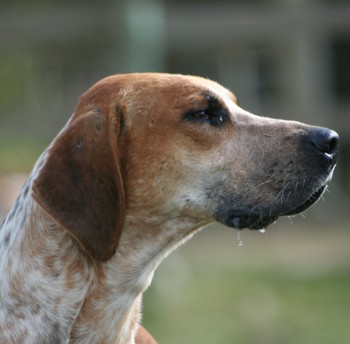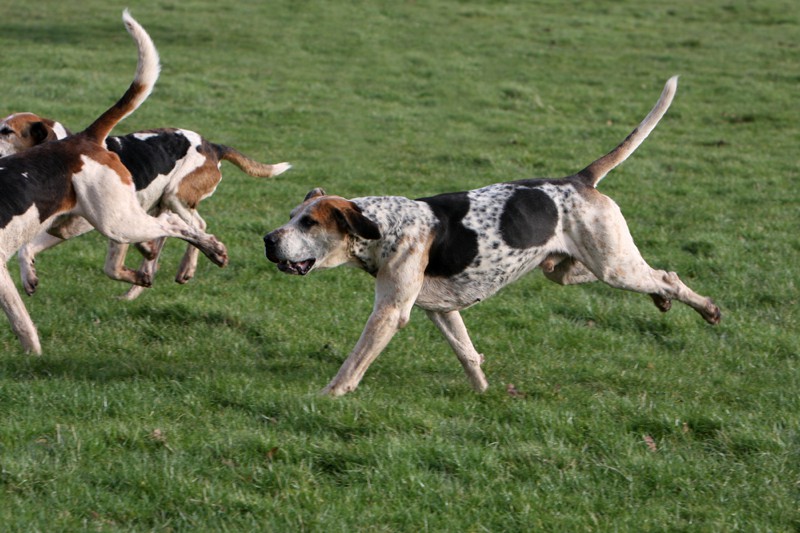English Foxhound

The English Foxhound is a large, gentle hound that is as comfortable in a family home as in a hunt kennel. It is an energetic and enthusiastic companion, developed in the sixteenth century in response to growing interest in fox hunting around this time. Today, it is known as an intelligent, easy-going dog that gets along well with other dogs and children, though it still retains its natural prey drive, which can be an issue with smaller pets. Most cannot be left unattended, except in the most secure of gardens, as they will ramble in search of scent trails worth pursuing.
Though the Foxhound will cope better with an owner who is absent during the working day than many other breeds, working owners must be prepared to provide walks once or twice a day to satisfy the dog’s need for exercise. The breed has a loud, baying bark that can prove to be a good deterrent to intruders, but is generally sociable with strangers once introduced. However, excessive barking is a potential problem, and one which must be borne in mind for city dwellers. English Foxhounds are generally easy to care for, and need little grooming. They have very few health problems, and have an average life expectancy of 11–13 years.
About & History
When deer hunting, the leisure pursuit of choice of the aristocracy for centuries, started to take its toll on wild deer populations in the sixteenth century, fox hunting began to gain in popularity. Unfortunately, the large breeds traditionally used for hunting deer (e.g., the Scottish Deerhound) had neither the stamina nor the agility to pursue this new quarry over the countryside. This situation resulted in the early development of the Foxhound as a mixture of Greyhound, Fox Terrier, and Bulldog lines. The result was a strong dog with a combination of speed, tenacity, and the ability to pursue its prey for five to seven hours without need of a break, up to two or three times in a single week.
The breed began to be exported around the world as early as the seventeenth century, and large numbers were brought to the United States at an early stage in its history to allow colonists continue hunting as a hobby. It was here that it was used in combination with other hound breeds, including French Foxhounds, such as the Anglo-Français, to develop the lighter American Foxhound. George Washington himself was among those involved in this breeding programme, and this newer breed quickly overtook the English Foxhound in terms of popularity in the US. Today, the breed is more frequently seen in show rings in America, while on this side of the Atlantic it has retained its place as a hunter, and is occasionally kept as a pet. While also shown in UK competitions, this is a relatively recent phenomenon. It gained early entry into the Kennel Club register in the 1880s, and was also one of the first breeds to be recognised by the AKC in 1909.
Appearance

A well-proportioned English Foxhound should have a noble appearance and dignified carriage, exuding courage and endurance. Its head is quite flat, with the crown in parallel to the strong, broad muzzle. The mouth has a clean scissor bite, and the well-developed lips are somewhat heavy with moderate flews. The ears are wedge-shaped, thick (to cope with scratches and cuts while navigating hedgerows), and lie flat to the head from their high position on the skull. The almond-shaped eyes are brown in colour.
The breed has a strong, wide back and neck, and carries an appreciable amount of muscle throughout. The ribs are well-sprung and the chest is broad and deep, although the abdomen does not have a marked tuck. The limbs are long and straight, moderately well-muscled, and end in relatively small paws that are often described as being cat-like. The tail is set high, and is carried below horizontal when relaxed, with a slight upward curl – it is thick at the base and tapers. When excited, the tail is held rigidly upright.
The Foxhound has a short, hard and coarse coat that may be almost any colour, with very variable markings. Males are usually 60–64 cm (24–25 in) tall at the withers, and females 58–62 cm (23–24 in) in height. Weights are very variable, but an average range for males would be 28–34 kg (62–75 lb), and for females 25–32 kg (55–70 lb).
Character & Temperament
Foxhounds are courageous and determined dogs in the field, characteristics that can also be seen when they are kept as pets. Whether taking their owner for a walk in pursuit of a scent trail, or scrambling to retrieve a nugget of food from under the sofa, the Foxhound is not easily deterred from something that attracts his attention. For this reason, the breed is often described as stubborn, and they do need a firm and consistent owner who is able to take control and redirect them when needed. They are very versatile dogs, and although they need space and should not be considered suitable apartment dogs, with a couple of half-hour walks each day and access to a good-sized garden, most are contented and easy to manage household companions.
Being a pack hound, they are extremely social animals, and get along very well with other dogs. Similarly, they are at their best when part of a large family, and their adaptable nature means they can transition from energetic exercise partner for the adults in the home to soppy playmate for the children with ease. Foxhounds can be very vocal, and will be sure to join in any canine chorus within earshot, and this, coupled with their tendency to bark at the sight of strangers, means they make excellent watch dogs.
Trainability

As mentioned above, English Foxhounds can be stubborn dogs, and training takes time and patience. One area in which they are particularly resistant to training is recall, meaning that they can never be trusted off the lead in open spaces. The sight or smell of another animal will quickly prove irresistible, and the Foxhound will happily lose itself in pursuit for hours on end.Microchipping of all Foxhounds is essential for this reason, as many eventually turn up an astonishing distance from home.
The breed’s vocal nature means that nuisance barking is a frequently reported problem. This can be managed, to some extent, by training them to “speak” and “cease” on command. This takes a good deal of patience to master, but can be a very valuable tool.
Health
The English Foxhound is a very healthy breed, and most individuals are never afflicted by the conditions listed below. However, as for all pedigrees, some problems are more common in the breed than in the general dog population.
Deafness
Congenital deafness is occasionally seen in Foxhound puppies, and usually becomes obvious from around six weeks of age as reduced responsiveness in affected pups. While deafness is a catastrophic disability for a working pack dog, pet Foxhounds can learn to adapt to this condition, and can live full and happy lives in the right home.
Epilepsy
This condition has no identifiable cause in the majority of cases, and causes episodes of involuntary muscle activity and altered consciousness. Most people associate the classic grand mal presentation with epilepsy, with its dramatic flailing limbs, loss of bladder control, and loss of consciousness, but epilepsy frequently takes the petit mal form.
This milder presentation may appear as lameness, facial tics, excess salivation, or compulsive fly-catching behaviour. The frequency and severity of these episodes determines the need for treatment, with dogs experiencing more than one grand mal event per month usually being started on anticonvulsant medications.
Familial Renal Amyloidosis
This is an uncommon cause of kidney failure, but has been reported in related English Foxhounds. Amyloidosis describes the build-up of inflammatory proteins within the matrix of the kidney, compressing the surrounding tissues and causing loss of function.
While kidney failure due to amyloidosis is usually a slowly progressive condition, Foxhounds affected by this form of the disease all appear to deteriorate very quickly, with most dying within one week of the onset of clinical signs.
Hound Ataxia
This is not a condition likely to be seen in pet Foxhounds, and has only been reported in pack dogs. It involves a dramatic loss of muscular coordination, is usually seen in dogs aged between two and seven years, and is thought to be associated with feeding a diet consisting largely of offal. It has also been described in working Beagles.
Microphthalmia
Some English Foxhounds are born with abnormally small, non-functioning eyes. This is an obvious defect that can be noticed by breeders and prospective buyers alike. Either one or both eyes may be affected.
Spinal Osteochondrosis
This is a degenerative condition affecting the spinal cord, and resulting in back pain and some degree of hindlimb lameness. It may be seen from middle age, with characteristic new bone formation in the lower back visible on X-ray examination. Unfortunately, there is no cure for the condition, and affected dogs usually need long-term management with painkillers and restricted exercise.
Thrombocytopathy
A disorder in which the ability of tiny white blood cells, called platelets, to plug holes in blood vessel walls is reduced. This results in a tendency to bleed profusely after minor trauma, which may first be noticed as lameness after vigorous exercise due to bleeding within joints or muscles.
Exercise and Activity Levels
English Foxhounds can adapt to a range of exercise regimes, but as might be expected, they do best with a minimum of one to two hours per day. Lead walking is adequate, but they can be far more energetic than this if allowed.
They are ideal companions for enthusiastic long distance runners and hikers, and are more than capable of completing a marathon training programme with all but the most elite of athletes. They need space, and the freedom to frolic around a decent-sized garden on a daily basis.
Grooming
The breed has a very easy to care for coat. It is short, hard, and dense, and does not allow dirt to cling on easily. Weekly brushing is usually enough to keep the coat clean and to remove dead hair, and even caked-on mud is easily removed in this manner once it has dried. Bathing is rarely required, and should only be done when absolutely necessary, as it can strip essential oils from the hair and skin.
Foxhounds have strong nails, and unless walked on paved surfaces, may need them trimmed every few weeks. This can be done at home with a good-quality nail clippers designed for dogs, once the owner takes care to avoid the sensitive “quick” containing nerves and blood vessels that runs down the centre of each nail. Tooth brushing is an excellent way to avoid dental problems later in life. This should be introduced to the Foxhound as a young pup, and needs to be done at least every other day for maximum benefit.
Famous English Foxhounds
While not household names, within the hunting fraternity, several well-known English Foxhounds are felt to exemplify the breed standard:
- Old Berkshire Grammar
- Belvoir Gambler
- VWN Smiler
- Old Dominion Gorgeous
- Bobby
Cross-Breeds
In working packs, Foxhounds are occasionally mixed with other breeds to make best use of their various strengths over the local terrain.
- Basset Foxhound Cross between an English Foxhound and a Basset Hound
- Mally Foxhound A more unusual cross between an English Foxhoud and an Alaskan Malamute
- Beagle Foxhound Cross between an English Foxhound and a Beagle

